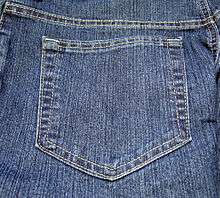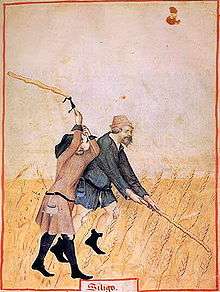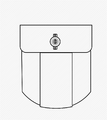
A pocket is a bag- or envelope-like receptacle either fastened to or inserted in an article of clothing to hold small items. Pockets may also be attached to luggage, backpacks, and similar items. In older usage, a pocket was a separate small bag or pouch.
Origins


Ancient people used leather or cloth pouches to hold valuables.[1] Ötzi, who lived around 3,300 BCE, had a belt with a pouch sewn to it that contained a cache of useful items: a scraper, drill, flint flake, bone awl and a dried fungus.[2]
In European clothing, fitchets, resembling modern day pockets, appeared in the 13th century. Vertical slits were cut in the super tunic, which did not have any side openings, to allow access to purse or keys slung from the girdle of the tunic.[3]
In slightly later European clothing, pockets began by being hung like purses from a belt, which could be concealed beneath a coat or jerkin to discourage pickpocketing and reached through a slit in the outer garment.
The word appears in Middle English as pocket, and is taken from a Norman diminutive of Old French poke, pouque, modern poche, cf. pouch. The form "poke" is now only used dialectically, or in such proverbial sayings as "a pig in a poke".
Historically, the term "pocket" referred to a pouch worn around the waist by women in the 17th to 19th centuries, mentioned in the rhyme Lucy Locket.[4]
Types
A watch pocket or fob pocket is a small pocket designed to hold a pocket watch, sometimes found in men's trousers and waistcoats and in traditional blue jeans.[5] However, due to the decline in popularity of pocket watches, these pockets are rarely used for their intended purpose.
A besom pocket or slit pocket is a pocket cut into a garment instead of being sewn on. These pockets often have reinforced piping along the slit of the pocket, appearing perhaps as an extra piece of fabric or stitching. Besom pockets are found on a tuxedo jacket or trousers and may be accented with a flap or button closure.
Camp pockets are pockets which have been sewn to the outside of the garment. They are usually squared off and are characterized by seaming.[6][7]
A beer pocket is a small pocket within a jacket or vest sized specifically for transporting a bottle of beer. It came into fashion in the 1910s in select areas of the American midwest, prior to Prohibition, after which it faded into relative obscurity before experiencing minor revivals in the 1980s and early 2000s.
Different Types of Pocket Designs
 Patch pocket.
Patch pocket. Patch pocket with topstitching.
Patch pocket with topstitching. Flap pocket.
Flap pocket. Buttoned-flap patch pocket with box pleat.
Buttoned-flap patch pocket with box pleat. "Smile" slit pocket with piping and arrowhead reinforcements, typical of western wear.
"Smile" slit pocket with piping and arrowhead reinforcements, typical of western wear. Welt Pocket.
Welt Pocket. Stand or single-welt pocket.
Stand or single-welt pocket. 18th century-style hanging pockets
18th century-style hanging pockets- Parts of a tailored pocket.
Sources
- ↑ "A History of Handbags". Random History. Retrieved April 23, 2016.
- ↑ "The Belt and Pouch". South Tyrol Museum of Archaeology. Retrieved April 23, 2016.
- ↑ Cunnington, C. Willett and Phillis (1969). Handbook of English Medieval Costume. Plays Inc.
- ↑ "Historic New England: Defining the Past. Shaping the Future". Spnea.org. Retrieved 2009-08-20.
- ↑ Levi Strauss & Co. Unzipped Team (17 April 2014). "Those Oft-Forgotten Pant Parts". Retrieved 2015-11-03.
- ↑ "What is "Camp Pockets" - Definition & Explanation". Retrieved December 1, 2011.
- ↑ "Glossary of fashion design terminology at Dress King". Retrieved December 1, 2011.
References
- Picken, Mary Brooks (1957). The Fashion Dictionary. Funk and Wagnalls.
- "Pockets". Fashion & Jewellery Features. Victoria and Albert Museum. Retrieved 2009-11-17.
- Different Types of Pocket
External links
| Wikimedia Commons has media related to pockets. |
- BBC - h2g2 - A Very Brief History of the Pocket
- 18th Century Women's Pockets
- Pockets at the V&A
- Pockets of History